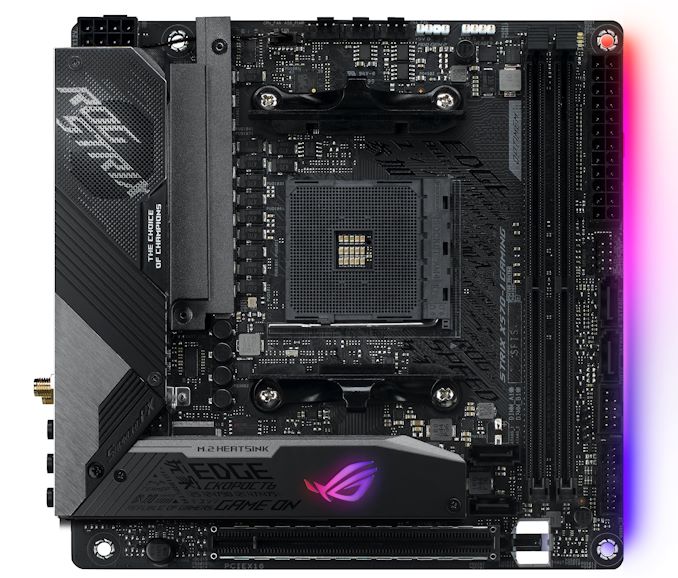The AMD X570 Motherboard Overview: Over 35+ Motherboards Analyzed
by Gavin Bonshor on July 9, 2019 8:00 AM ESTASUS ROG Strix X570-I Gaming
The ASUS ROG Strix X570-I Gaming is a small form factor gaming-focused and represents its more mid-range Strix brand. Based on the smaller Mini-ITX form factor, the X570-I Gaming has plenty to shout about including two PCIe 4.0 M.2 slots and eight SATA ports which is quite impressive for a small form factor to feature.
There is a single full-length PCIe 4.0 x16 slot in addition to two memory slots with support for up to 64 GB of DDR4 memory. The aesthetic is similar to the ATX sized X570 Strix models with a graffiti-inspired graphic on the M.2 heatsink, which also extends around to the rear panel cover for a uniformed look. There is RGB LED lighting built into the heatsink, with a strip underneath the right-hand side of the PCB for an ambient styled glow. In terms of storage, the ASUS ROG Strix X570-I Gaming has eight SATA ports and two PCIe 4.0 x4 M.2 slots; one is located on the front just above the full-length PCIe 4.0 x16 slot which includes a heatsink, while the other sits on the rear of the boards PCB.
Aimed at the mid to high-end gamers, the ASUS ROG Strix X570-I Gaming has a ROG SupremeFX S1220 HD audio codec which powers three 3.5 mm audio jacks, with three USB 3.1 G2 Type-A, one USB 3.1 G2 Type-C, and four USB 3.1 G1 Type-A ports also on the rear panel. Interestingly ASUS includes a DisplayPort 1.4 and HDMI 2.0 pairing of video outputs on the rear for use with the newly announced AMD Ryzen 3000 series APUs. The ROG Strix X570-I rear panel also has an Intel I211-AT Gigabit NIC powering the single Ethernet port, as well as an Intel AX200 802.11ax Wi-Fi 6 wireless interface which also includes support for BT 5.
The ASUS ROG Strix X570-I Gaming at present doesn't have an MSRP as isn't being launched with the rest of its product stack, and it represents the only mini-ITX sized model in the line-up; the ROG Crosshair VIII Impact is actually mini-DTX. A mixture of premium components, good storage capabilities and a Wi-Fi 6 802.11ax wireless interface an attractive model for users looking to build a potent small form factor gaming system.











225 Comments
View All Comments
DigitalFreak - Tuesday, July 9, 2019 - link
I think the only advantage of using a 2000 series CPU with an X570 board will be PCIe 3.0/4.0 support. The X370/X470 only supported PCIe 2.0. In theory, the connection from the 2000 processor to the X570 chipset should run at PCIe 3.0 speeds.FreckledTrout - Tuesday, July 9, 2019 - link
The x370 chipset and x470 both supported PCIe 3.0 with either a 1xxx or 2xxx Ryzen CPU. If you are not running a 3xxx CPU in the x570 board there isn't any major feature that should cause one to want to upgrade.DigitalFreak - Tuesday, July 9, 2019 - link
@FreckledTrout - Yes and no. The interconnect between the CPU and the chipset is PCIe 3.0 on X370 / X470, but all the PCIe lanes that come off the chipset are 2.0. Running a 2000 series CPU in an X570 board would give you a PCIe 3.0 link between the CPU and the chipset, with either PCIe 3.0 or 4.0 lanes coming off the chipset (depends on if AMD drops everything to PCIe 3.0 with a 2000 series processor).extide - Tuesday, July 9, 2019 - link
It looks like they still allow the chipset lanes to be 4.0. So you'd have 3.0 link to cpu, but 4.0 from chipset to devices.Targon - Thursday, July 11, 2019 - link
Since you have at least one or two PCI Express slots that are connected to the CPU, not chipset, that almost becomes a non-issue. On my Asus ROG Crosshair VI Hero(X370), you have PCI Express 3.0 x16 for the first slot, or x8/x8. The third PCI Express x16 slot is a 2.0 I believe, which is still enough to get the job done for many devices. Even with the X570 board with a first or second generation Ryzen processor, the most you end up with is an extra 3.0 supporting slot. Note that many boards may have x16 slots, but they are x8 electrically, so you won't see the full bandwidth anyway in those slots.sorten - Tuesday, July 9, 2019 - link
Thanks Gavin! This is a great resource and is exactly what I needed to help build my new system.willis936 - Tuesday, July 9, 2019 - link
The return of the 40mm fan! Those are the most obnoxious components ever. No one has missed them in the past ten years.Kastriot - Tuesday, July 9, 2019 - link
Buy Asrock aqua and problem solved.FreckledTrout - Tuesday, July 9, 2019 - link
I'm waiting for the next iteration of board for this reason. I'm speculating the next round the chipset will be on 7nm.abufrejoval - Tuesday, July 9, 2019 - link
The genious about that chiplet design is that the chipset doesn't actually benefit nearly as much from the shrink, as pure logic or SLC caches: The monolithic guys pay the 7nm overhead (e.g. EUV) for I/O while the geometry of the transistors in the I/O area is mostly determined by the need to power long motherbord or even slot traces.So while waiting is never a bad idea when your need clearly isn't overwhelming you, waiting for that shrink could turn out rather long. These days I/O heave chips might never be done in smaller geometries, because of that and because packaging has matured.